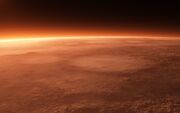
|
I can see advantages.
The following article is not maintained by the content's author and is currently being reserved by the community. |

|
I'm rusty... XD
The following article is full of language errors. Please help to fix all the errors then remove this notice once is fixed. |
Mars is the fourth planet from the Sun and the second smallest planet in the Solar System after Mercury. Named after the Roman god of war, it is often referred to as the "Red Planet" because the iron oxide prevalent on its surface gives it a reddish appearance. Mars is a terrestrial planet with a thin atmosphere, having surface features reminiscent both of the impact craters of the Moon and the volcanoes, valleys, deserts, and polar ice caps of Earth.
Description[]
Geology[]
Mars' surface is a dry, barren wasteland marked by old volcanoes and impact craters. The entire surface can be scoured by a single sand storm that hides it from observation for days at a time. Despite the formidable conditions, Mars' surface is better understood by scientists than any other part of the Solar System, except Earth.

Mars' arid surface
Mars is a small world. Its radius is half of the Earth’s and its mass is less than one tenth of Earth's. The Red Planet’s total surface area is about 28% of Earth. While that does not sound like a large world at all, it is nearly equivalent to all of the dry land on Earth. The surface is thought to be mostly basalt, covered by a fine layer of iron oxide dust that has the consistency of talcum powder. Iron oxide(rust as it is commonly called) gives the planet its characteristic red hue.
The Martian surface is dotted with impact craters. Most of these craters are still intact because there are no environmental forces to erode them. The planet lacks the wind, rain, and plate tectonics that cause erosion here on Earth. The atmosphere is much thinner than Earth’s so smaller meteorites are able to impact the planet.
Climate[]
Of all the planets in the Solar System, the seasons of Mars are the most Earth-like, due to the similar tilts of the two planets' rotational axes. The lengths of the Martian seasons are about twice those of Earth's because Mars' greater distance from the Sun leads to the Martian year being about two Earth years long. Martian surface temperatures vary from lows of about −143 °C (−225 °F) at the winter polar caps to highs of up to 35 °C (95 °F) in equatorial summer. The wide range in temperatures is due to the thin atmosphere which cannot store much solar heat, the low atmospheric pressure, and the low thermal inertia of Martian soil. The planet is also 1.52 times as far from the Sun as Earth, resulting in just 43% of the amount of sunlight.
If Mars had an Earth-like orbit, its seasons would be similar to Earth's because its axial tilt is similar to Earth's. The

Mars climate has extreme temperatures.
comparatively large eccentricity of the Martian orbit has a significant effect. Mars is near perihelion when it is summer in the southern hemisphere and winter in the north, and near aphelion when it is winter in the southern hemisphere and summer in the north. As a result, the seasons in the southern hemisphere are more extreme and the seasons in the northern are milder than would otherwise be the case. The summer temperatures in the south can reach up to 30 K (30 °C; 54 °F) warmer than the equivalent summer temperatures in the north.
Mars also has the largest dust storms in the Solar System. These can vary from a storm over a small area, to gigantic storms that cover the entire planet. They tend to occur when Mars is closest to the Sun, and have been shown to increase the global temperature.
Points of Interest[]
Tithonium Canyon[]

Tithonium Canyon prior the war.
This small area is surrounded by mountains and has great slopes and some bridges in the middle.
Tharsis Rift[]

A copter flying near a tower in Tharsis Rift.
A very mountainous sector, it contains deep canyons that allow runners to sneak up on the enemy base while tanks fight it out in the middle, where the terrain is more favorable. The system of bridges and canyons leads to two "layers" of battle. In this sector there are curious "mushroom" shaped rocks that shelter ground vehicles from planes and a canyon you can use to sneak along the entire sector.
Hellion Impact Crater[]

A shot from Hellion Impact Crater through the Mothership Deploy System
One of the first sectors that became a warzone, the Hellion Impact Crater has bases that are protected by large rock pillars, creating a natural gate. This sector is very open with few hills for cover. There is an elevated path around the outside. This place is also used as practice for beginners.
